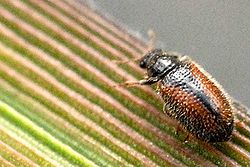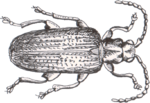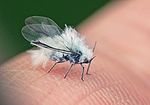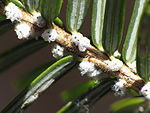Tooth-necked fungus beetle
| Tooth-necked fungus beetle |
|---|
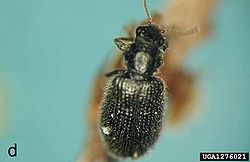
|
| Scientific Classification |
|
| Genera |
| Members of derodontidae are small animals, feeding on fungus, and, in the case of Laricobius, on other insects. |
Derodontidae, a family of beetles, is one of the least known members of Coleoptera. Members of this family, as implied by their common name, eat fungi and their byproducts; they are completely dependent on the spore producing organisms. These creatures, though they make their home all over the world, are relatively rare, though a beetle enthusiast may relish the challenge to capture one. These animals are small, but have large appetites, and can become huge pest for farmers of fungi. Though little research has been performed on the processes and intricacies of derodontidae, several of its members, specifically species Laricobius are extremely important biological control agents, employed on the eastern coasts of the U.S and Canada to control several large pests. They have a very large untapped potential, the members of this family are just waiting for someone to discover all the abilities God has designed them for.
Body Design
Derodontidae, a family of beetles is part of its own superfamily, Derodontoidea. Members of this family are commonly known as tooth-necked fungus beetles. They are closely related to the Bostrichoidea, of which the death watch beetles, skin beetles, and powder-post beetles belong to. There are about 10 species in 4 genera in Derodontidae.
Members of Derodontidae are relatively small, between 2 and 6 mm in length, with spiny margins on their pronotum (part of the thorax) [3] of which they are named after. The Laricobius, a genus of Derodontidae, doesn't have these spines. They have two ocelli (a type of simple eye common to invertebrates, consisting of retinal cells, pigments, and nerve fibers.)[4] on the top of their heads.[5] Their maxillae (one of the paired appendages immediately behind the mandibles of arthropods) [6] are exposed at the base. Their antennae are inserted before their small, prominent eyes and have large elytra, (hardened forewings of certain insects, as beetles, forming a protective covering for the posterior or flight wings.) [7] which completely cover the abdomen. The tooth-necked fungus beetle's legs are moderate for its size. The colorings of the members of this family are usually brown, brick-red, brownish-red, or brownish-yellow.
Life Cycle

The tooth-necked fungus beetle, like every other beetle, goes through four stages of development, known as complete metamorphosis. The mother will lay a large amount of bright yellow eggs in a hidden area, but the mother does not protect her young. As the beetle matures, it will eventually hatch from its egg, but it is not yet in a form recognizable to most people. The newly born tooth-necked fungus beetle will be in its larval stage. The tooth-necked fungus beetles' larvae resembles the lady bugs' though the tooth-necked fungus beetles' is bright yellow [9] The larvae will continue to grow as it eats, shedding its exoskeleton several times as it grows. When the beetle reaches a preordained period, usually defined by food or season, the larvae will enter a pupal period, in which the larvae will undergo radical changes in its body. The pupae for the tooth-necked fungus beetle is also bright yellow, but darkens as it matures.[10].After a period of about nine months, the beetle will emerge from its pupae, and an adult tooth-necked fungus beetle is born! [11]
Ecology
Beetles historically have been a very hardy species. They populate almost all environments and climates, and the tooth-necked fungus beetles are no exception. Members of family Derodontiae range from Japan to Oregon to Taiwan to Alaska, inhabiting a large portion of the world. [12] They prefer a temperate clime, however, and one that has abundant amounts of fungi. Also, despite their wide range of population, this beetle is rather rare and uncommonly discovered. All tooth-necked fungus beetles, with the exception of the species Laricobius, feed either on fungi directly or on the results of the fungal metabolism. Peltastica seem to eat the result of fungal fermentation while Derodontus eat the actual body of the fungus Basidiomycetes. So, as the method and style of feeding may vary, all members of derodontidae rely greatly on fungus for food.
However, as mentioned earlier, the species Laricobius does not feed on fungus, making it a very beneficial anomaly within Derodontidae. The reason being that Laricobius feeds on the Hemlock Woolly Adelgid and the woolly aphid, two very harmful insects that ravage the vegetation of the U.S. and Canada.
Effects on the Environment
The Hemlock Woolly Adelgid is an invasive pest within the eastern United States. Laricobius osakensis Montgomery and Shiyake, both proud members of the family Derodontidae, are being tested to see whether they will prove to be an effective control agent of the Hemlock Woolly Adelgid. [14] Laricobius nigrinus Fender, a species native to western North America, have been introduced into the Eastern United States already in 2003 to help control this creature. [15] They are an effective biological controller over the woolly adelgid. Members of Derodontidae ( L. erichsonii) have already been introduced into Canada in the 1950's to control the woolly aphid. [16] There is rigorous testing of the beetles to make sure they will not end up harming the environent rather than helping it, like in the disastrous case of the cane toad. These tests include: no choice and paired choice feeding, oviposition (Oviposition is the process of laying eggs by oviparous animals.) [17] and develpment tests with the invasive species, three other adelgids, and three nonadelgids. [18]
Gallery
References
- ↑ Myers, P., R. Espinosa, C. S. Parr, T. Jones, G. S. Hammond, and T. A. Dewey. Derodontidae. The Animal Diversity Web. Web. October 26, 2011.
- ↑ Derodontidae. Free Species Directory. Web. last modified: May 17,2011, at 03:39. Author unknown.
- ↑ Pronotum. Complete & Unabridged 10th Edition. HarperCollins Publishers. Web. accessed at: November 8, 2011. Author unknown.
- ↑ Ocelli. Dictionary.com Unabridged.. Random House Inc. Web. accessed at: November 8,2011. Author unknown.
- ↑ Research Results For 'Derodontidae'. probertencyclopaedia.com. Web. accessed at:November 8,2011. Author unknown.
- ↑ maxillae. Dictionary.com Unabridged.. Random House Inc. Web. accessed at: November 8,2011. Author unknown.
- ↑ elytra. Dictionary.com Unabridged.. Random House Inc. Web. accessed at: November 8,2011. Author unknown.
- ↑ John Lawrence LeConte. Anatomy Of Derodontidae. Classification of the Coleoptera of North America, Parts 1-2. Web. accessed at: November 8,2011.
- ↑ G.M.G Zilahi-Balog, L.M. Humble, L.T. Kok, and S.M. Salom.Life Stages of Laricobius nigrinus. Morphology of Laricobius Nigrinus, a predator of the hemlock woolly adelgid. Web. November 14, 2005.
- ↑ G.M.G Zilahi-Balog, L.M. Humble, L.T. Kok, and S.M. Salom.Life Stages of Laricobius nigrinus. Morphology of Laricobius Nigrinus, a predator of the hemlock woolly adelgid. Web. November 14, 2005.
- ↑ The life cycle of a Beetle. Animal Corner. Web. accessed at: November 8,2011. Author unknown.
- ↑ Jiří Háva. World Catalogue of the Family Derodonytidae (Coleoptera). World Catalogue of the Family Derodonytidae (Coleoptera). Web. Published: 2010.
- ↑ D.E. Bright Overview of Derodontidae. FAMILY DERODONTIDAE (tooth necked fungus beetles). Web. Accessed at: November 21, 2011.
- ↑ G M G Zilahi-Balogh, L M Humble, L T Kok, S M Salom. Derodontidae As a Biological Control Agent. A New Species of Laricobius (Coleoptera: Derodontidae) from Japan with Phylogeny and a Key for Native and Introduced Congeners in North America. Web. September 8, 2010.
- ↑ G M G Zilahi-Balogh, L M Humble, L T Kok, S M Salom. Potential for Laricobius Nigrinus As a Biological Control Agent. Morphology of Laricobius nigrinus (Coleoptera : Derodontidae), a predator of the hemlock woolly adelgid. Web. 2006
- ↑ D.E. Bright Overview of Derodontidae. FAMILY DERODONTIDAE (tooth necked fungus beetles). Web. Accessed at: November 21, 2011.
- ↑ oviposition. Dictionary.com Unabridged.. Random House Inc. accessed at: November 3, 2011. Author unknown
- ↑ L. C. Vieira,1 T. J. Mcavoy, J. Chantos, A. B. Lamb, S. M. Salom, and L. T. Ko'. Laricobius osakensis: A New Biological Control. Host Range of Laricobius osakensis (Coleoptera: Derodontidae), A New Biological Control. Web. July 30, 2010.
